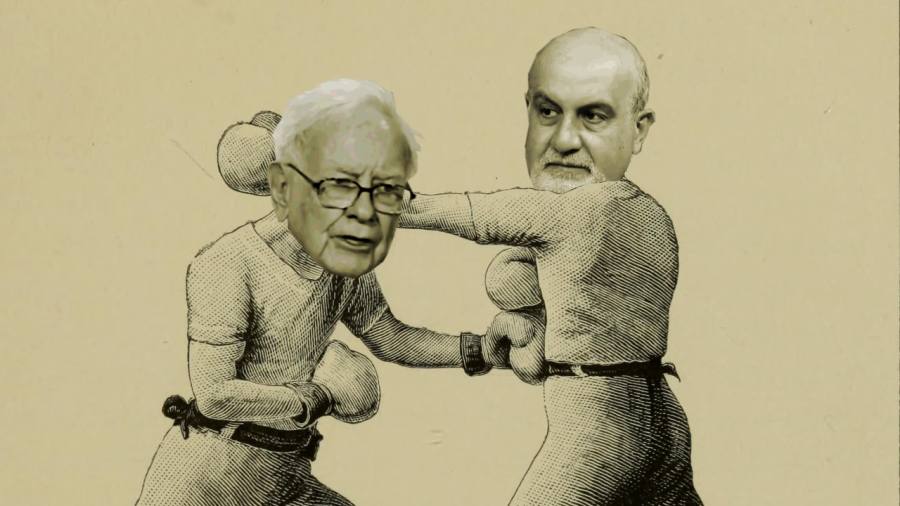Receive free Capital markets updates
We’ll send you a myFT Daily Digest email rounding up the latest Capital markets news every morning.
Pablo Triana is a former professor at ESADE Business School and the author of Lecturing Birds on Flying and The Number that Killed Us.
Between 2004 and 2008, Warren Buffett sold an absolute boatload of derivatives contracts. Back in 2013 I tried to dissect the trade — an analysis Alphaville covered here and here — but now that the positions have all been closed out it makes sense to do a final autopsy.
Remember, the size of the positions was humongous. At the peak the nominal size of Berkshire Hathaway’s positions was about $40bn of equity index puts and $30bn of credit-default swaps, many of which were long-term, volatile exposures.
Many were surprised to see the great Sage of Omaha engage in something that has sunk so many punters — both professional and amateur — and often considered intolerably reckless. As even Buffett himself had famously said about derivatives back in his 2002 letter to investors:
The derivatives genie is now well out of the bottle, and these instruments will almost certainly multiply in variety and number until some event makes their toxicity clear. Knowledge of how dangerous they are has already permeated the electricity and gas businesses, in which the eruption of major troubles caused the use of derivatives to diminish dramatically. Elsewhere, however, the derivatives business continues to expand unchecked. Central banks and governments have so far found no effective way to control, or even monitor, the risks posed by these contracts.
Charlie and I believe Berkshire should be a fortress of financial strength — for the sake of our owners, creditors, policyholders and employees. We try to be alert to any sort of megacatastrophe risk, and that posture may make us unduly apprehensive about the burgeoning quantities of long-term derivatives contracts and the massive amount of uncollateralized receivables that are growing alongside. In our view, however, derivatives are financial weapons of mass destruction, carrying dangers that, while now latent, are potentially lethal.
Adding to the piquancy, Buffett’s big fat derivatives trade came just as Nassim Nicholas Taleb’s own dim views of derivatives selling were coming to the fore. Suddenly, we had two seemingly diverging core market philosophies playing out: the benefits and dangers of selling protection. The outcome of the trade was therefore of massive interest to both the practice and theory of finance.
Well, we now know the answer.
All the derivatives contracts having essentially expired by now, and it’s clear Buffett made a lot of hard cash from the trade. I estimate that he collected about $9bn of premiums while making out payments of just under $4bn.
As Buffett said when justifying the positions in 2009:
Considering the ruin I’ve pictured, you may wonder why Berkshire is a party to 251 derivatives contracts (other than those used for operational purposes at MidAmerican and the few left over at GenRe). The answer is simple: I believe each contract we own was mispriced at inception, sometimes dramatically so. I both initiated these positions and monitor them, a set of responsibilities consistent with my belief that the CEO of any large financial organization must be the Chief Risk Officer as well. If we lose money on our derivatives, it will be my fault.
It’s therefore tempting to declare that Buffett was fully vindicated. The reality is more nuanced, and no one should take Buffett’s success as a signal to do anything similar.
Yes, Buffett’s trade did work marvellously in practice, and that’s not even counting the investment returns he would have achieved on those premiums — in reality, the real reason why he did the trade in the first place. But that doesn’t mean that Talebsian philosophy has been of vanquished by Buffet’s narrow factual win.
The reality is that Buffett’s trade faced throughout its lifespan not one but two monstrously chaotic turbulent market events — the global financial crisis and the Covid-19 shock — which would typically wipe any naked sellers of equity and credit market protection.
So why did Buffett thrive? Well, he enjoyed some major benefits, which helped him avoid the fate of many others that followed a similar strategy at the time.
1) Buffett was allowed by his transaction counterparties to (almost) not have to post precious cash collateral.
2) Buffett was allowed a lot of leeway to determine his accounting losses himself.
3) Buffett was not (or was not allowed to be) too greedy. The negative consequences from the trade would have been very different had notional amounts been a lot higher or at different levels.
4) Luck. The size of the exposure had been largely reduced by the time Covid-19 showed up and sent markets into another tailspin.
Buffett’s beet shows that it is in principle possible to obtain extremely cheap financing (negative-cost financing actually) through large risk-taking.
But anybody else selling similarly massive amounts of long-dated derivatives at the time Buffett did — but without Buffett’s comparative advantages and luck — may not have survived financially. The Talebsian view of finance has still been vindicated.
Read the full article here



